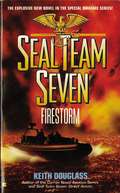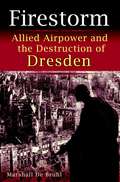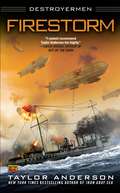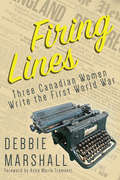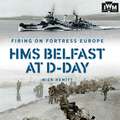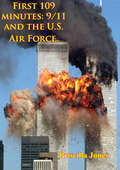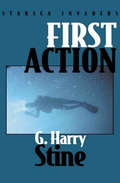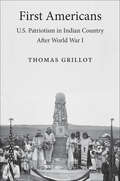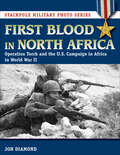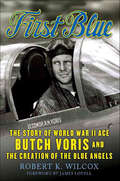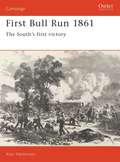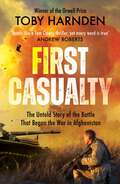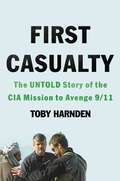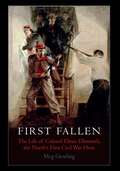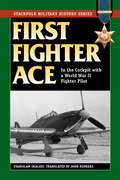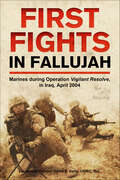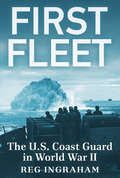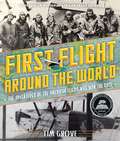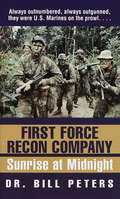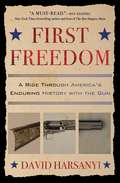- Table View
- List View
Firestorm (Seal Team Seven, #5)
by Keith DouglasThanks to SEAL Team Seven, Platoon 3, the CIA has discovered a Chinese plot to invade Taiwan. The invasion plan is divided up into four phases. Platoon 3 is tasked with interdicting all four phases of the operation before the Chinese military is prepared to strike--four separate missions in two days.
Firestorm (Security Specialists International #6)
by Monette Michaels“The tough, protective heroes you’ve been waiting for. Fans of Maya Banks’ KGI, Susan Stoker, and Lexi Blake will love Monette Michaels’ Security Specialists International series.” —Cherise Sinclair, NY Times and USA Today Bestselling Author. She's a survivor.Former Air Force pilot Tara Nightwalker survived wartime flying only to come home to a civilian life that was anything but safe. Two years after surviving a brutal kidnapping, it’s time to get on with her life. She finds a job in Idaho as a park ranger and wildland firefighting instructor. After what she’s been through, men aren’t appealing at all. Not until she meets SSI operative Price Teague. He’s strong. Honorable. A warrior. And she knows in her gut … he’s the one.The only problem is—he doesn't seem interested. He's a patient warrior.Price Teague envies his fellow SSI operatives who’ve found women to love, because he sure hasn’t been as lucky. Not until the tough, beautiful firefighting instructor comes into his life. The day that some bastard in the woods shoots at them, Tara is cool, calm, and courageous in the face of danger. He recognizes instantly this is the woman he wants.He’s usually a direct-action sort of guy, but he can see Tara is wary about men. Maybe she’s been hurt in the past. He’ll take it slow ... even if it kills him. But when her kidnapper escapes prison, bent on revenge, Price throws out the slow-and-steady approach. Time is not on his side, and there's no way he'll let anyone hurt her.Danger is all around. Then fire season kicks into gear.“Ms. Michaels' writing is tight, the dialogue is witty and it deserves to be on your "MUST READ" list.” –John Matteson, Goodreads.Read all of Monette Michaels' series: Security Specialists International1 - Eye of the Storm1.5 - Stormy Weather Baby2 - Cold Day in Hell2.5 - Storm Front3 - Weather the Storm4 - Storm Warning 4.5 - Hot as Hell5 - An Ill WindThe Prime Chronicles1 - Prime Obsession2 - Prime Selection3 - Prime Imperative3.5 - Prime Claiming4 - Prime TargetThe Gooden and Knight Mysteries 1 - A Virtuous Vampire2 - The Deadly Séance
Firestorm: Allied Airpower and the Destruction of Dresden
by Marshall De BruhlOn February 13 and 14, 1945, three successive waves of British and U.S. aircraft rained down thousands of tons of high explosive and incendiary bombs on the largely undefended German city of Dresden. Night and day, Dresden was engulfed in a vast sea of flame, a firestorm that generated 1,500-degree temperatures and hurricane-force winds. Thousands suffocated in underground shelters where they had fled to escape the inferno above. The fierce winds pulled thousands more into the center of the firestorm, where they were incinerated. By the time the fires burned themselves out, many days later, a great city-known as "the Florence on the Elbe"-lay in ruins, and tens of thousands, almost all of them civilians, lay dead.In Firestorm, Marshall De Bruhl re-creates the drama and horror of the Dresden bombing and offers the most cogent appraisal yet of the tactics, weapons, strategy, and rationale for the controversial attack. Using new research and contemporary reports, as well as eyewitness stories of the devastation, De Bruhl directly addresses many long-unresolved questions relating to the bombing: Why did the strike occur when the Allies' victory was seemingly so imminent? Was choosing a city choked with German refugees a punitive decision, intended to humiliate a nation? What, if any, strategic importance did Dresden have? How much did the desire to send a "message"-to Imperial Japan or the advancing Soviet armies-factor into the decision to firebomb the city?Beyond De Bruhl's analysis of the moral implications and historical ramifications of the attack, he examines how Nazi and Allied philosophies of airpower evolved prior to Dresden, particularly the shift toward "morale bombing" and the targeting of population centers as a strategic objective. He also profiles the architects and prime movers of strategic bombing and aerial warfare, among them aviation pioneer Billy Mitchell, RAF air marshal Sir Arthur "Bomber" Harris, and the American commander, General Carl Spaatz.The passage of time has done nothing to quell the controversy stirred up by the Dresden raid. It has spawned a plethora of books, documentaries, articles, and works of fiction. Firestorm dispels the myths, refutes the arguments, and offers a dispassionate and clear-eyed look at the decisions made and the actions taken throughout the bombing campaign against the cities of the Third Reich-a campaign whose most devastating consequence was the Dresden raid. It is an objective work of history that dares to consider the calculus of war.From the Hardcover edition.
Firestorm: Destroyermen
by Taylor AndersonBURNING WATERS Designated Supreme Commander of the Allied Forces, Matt Reddy must now contend with a new threat; the Dominion—humans whose lust for power matches the Grik. But even though the Grand Alliance recognizes the danger of the Dominion, it must deal with the land-based Grik first, leaving the Imperial navy—and USS Walker—with little assistance. As war rages, more Japanese ships come through the time-space maelstrom that the Americans call The Squall. One is a “Hell Ship,” carrying prisoners of an Imperial Japan that is growing ever more ruthless in the face of looming defeat. Escorting it is a new, state-of-the-art destroyer, whose officers recognize no rules of war. Fighting on two fronts, Reddy is plunged into a firestorm of loyalty, betrayal, and sacrifice. But nothing can prepare him for a devastating new Grik weapon—a weapon that could wipe out all who oppose them…
Fireweed
by Jill Paton WalshTwo teenage runaways who refuse to be evacuated from London struggle for survival amid the 1940 Blitz.
Fireworks Tonight!
by Martha BrennerFrom the Book Jacket: Streams of sparks and sprays of colored stars light up the dark sky, thundering blasts echo all around ... FIREWORKS TONIGHT! For centuries man has been playing with fire with dazzling, sometimes dire, results-and few things have as much power to astound and intrigue us. Martha Brenner's research has turned up a wealth of fascinating information on the world of pyrotechnics. She covers the history of fireworks from the primitive firecrackers developed some 2000 years ago in China to the breathtaking special effects of today, the tragic accidents that have led to current laws regulating their use, the intriguing step-by-step development of a modern fireworks show from the drawing board to the actual shooting. How are fireworks made? Very carefully! And almost entirely by hand, because metal machinery produces heat and static electricity that could easily ignite an entire building full of explosives. Who makes fireworks? Most are manufactured by a handful of dynamic, devoted families that have passed on their tricks and trademarks for generations. Fireworks Tonight! gives us profiles of them and their particular pyrotechnical styles. How do fireworks work? Martha Brenner explains that, too-in clear, scientific detail. And there's more. Fireworks Tonight! includes a trip behind the scenes at a fireworks show, a visit to a manufacturing plant, a section on safety, a list of the 50 states' current laws on their sale and use, an illustrated spectators' guide-to help fire works fans tell a roman candle from a rocket and a list of notable fireworks facts: the biggest display in history, the loudest, the longest .. . Generously illustrated with over 60 photo graphs and prints, Fireworks Tonight! is a lively, accurate, and comprehensive introduction to a subject of universal appeal.
Firing Lines: Three Canadian Women Write the First World War
by Debbie Marshall Anna Maria TremontiRead between the front lines: The stories of three Canadian female journalists stationed in England and France during the First World War. Europe: 1914–18. Mary MacLeod Moore, a writer for Saturday Night Magazine, covered the war’s impact on women, from the munitions factories to the kitchens of London’s tenements. Beatrice Nasmyth, a writer for the Vancouver Province, managed the successful wartime political campaign of Canadian Roberta MacAdams and attended the Versailles Peace Conference as Premier Arthur Sifton’s press secretary. Elizabeth Montizambert was in France during the war and witnessed the suffering of its people first-hand. She was often near the fighting, serving as a canteen worker and writing about her experiences for the Montreal Gazette. The reportage from these three women presents an insightful, moving, funny, and compelling body of observations of a devastating conflict, from underrepresented points of view. Firing Lines is based on the letters, articles, and books they wrote, as well as the records of those who knew them. The book offers a fresh perspective on a war that touched nearly every Canadian family and changed our sense of ourselves as a nation.
Firing on Fortress Europe: HMS Belfast at D-Day
by Nick HewittOn 6 June 1944, HMS Belfast supported troops in action on the beaches of Normandy in the campaign to liberate Europe from Nazi Germany. This audiobook recounts this extraordinary story, focusing on the dramatic events of 6 June but setting the context of the ship's history in the Arctic Convoy Service and Battle of North Cape. It describes the build-up to D-Day as seen and experienced by Belfast's people, and explains her role in the longer Battle for Normandy. Using first-hand accounts from IWM's rich collection of oral testimonies, diaries, and memoirs, HMS Belfast at D-Day brings to life her leading role in the largest invasion operation in history."Firing On Fortress Europe presents first-hand, personal accounts of members of HMS Belfast's crew alongside her log books to bring to life the role the ship played in the invasion in 1944."-- The Irish News"A number of first-hand, personal accounts of members of HMS Belfast - the Royal Navy warship from which one of the first shots of D-Day was fired - have also been revealed in a new book, Firing On Fortress Europe, published by the museum. It presents the accounts from the ship's crew alongside her log books to bring to life the role the ship played in the invasion in 1944. Accounts, images, journals and recorded interviews reveal stories from King George VI visiting before HMS Belfast left British waters, to narrowly avoiding explosions, rescuing and treating the wounded and going ashore to clear the beaches."-- The Daily Mail(P)2022 Headline Publishing Group Limited
First 109 Minutes: 9/11 And The U. S. Air Force
by Priscilla D. JonesTuesday, Sep. 11, 2001, dawned cool and clear, with sunny skies all along the eastern seaboard. For Air Force aviators like Lt. Col. Timothy "Duff" Duffy of the 102d Fighter Wing at Otis Air National Guard Base, Massachusetts, the day held the promise of perfect flying weather, at a time when the U.S. civil aviation system was enjoying a period of relative peace, despite concerns about a growing terrorist threat. More than ten years had passed since the last hijacking or bombing of a U.S. air carrier. That morning, however, the country came under a shocking, coordinated aerial assault by nineteen al Qaeda hijackers...The attack plan carried out by the suicide operatives had been years in the making. It was intended to cause mass, indiscriminate casualties and to destroy or damage the nation's financial, military, and political centers, four high value U.S. targets selected by bin Laden, independent operator Khalid Sheikh Mohammed, and al Qaeda operations chief Mohammed Atef...By the time 1 World Trade Center, North Tower, collapsed at 10:28 a.m. EDT, almost three thousand people had been killed or were dying; the financial center of the U.S. had been reduced to burning, toxic rubble; the iconic symbol of the military strength of the country had been severely damaged; the tranquility of a field in Pennsylvania had been shattered; U.S. Air Force and Air National Guard fighter aircraft had set up combat air patrols over Washington, D.C., and New York City; and the administration of President George W. Bush and the Department of Defense (DOD) had begun shifting major resources of the federal government and military services to a new national priority, homeland defense.
First Action: Starsea Invaders (Starsea Invaders #1)
by G. Harry StineThe Pacific Island port of Makasar used to be a fairly peaceful outpost of the United States Navy. But now, entire American families are vanishing without a trace and no one has any ideas about where they might be. William M. Corry, captain of the super-sub U.S.S. Shenandoah has orders to get to the bottom of the mysterious disappearances. At first, he suspects the unpredictable Chinese troopers patrolling the area, but after a little investigating, Corry realizes that the disappearances of the Americans cannot be the fault of the Chinese—they are as worried as he is. Corry refuses to believe the wild rumors of native cannibals…until he accidentally unearths the real enemy: a force with power beyond anything humankind has ever known!
First Americans: U.S. Patriotism in Indian Country after World War I
by Thomas GrillotThe little-known story of how army veterans returning to reservation life after World War I transformed Native American identity. Drawing from archival sources and oral histories, Thomas Grillot demonstrates how the relationship between Native American tribes and the United States was reinvented in the years following World War I. During that conflict, twelve thousand Native American soldiers served in the U.S. Army. They returned home to their reservations with newfound patriotism, leveraging their veteran cachet for political power and claiming all the benefits of citizenship—even supporting the termination policy that ended the U.S. government&’s recognition of tribal sovereignty.
First Blood in North Africa: Operation Torch and the U.S. Campaign in Africa in WWII (Stackpole Military Photo Series) (Stackpole Military Photo Series)
by Jon Diamond Dr.A pictorial history of America&’s first major military campaign in Africa during WWII. In November 1942, eleven months after Pearl Harbor, the U.S. launched Operation Torch, a multipronged attack on French North Africa—a region controlled by Germany through Vichy France. Led by Generals Eisenhower and Patton, it was America&’s first major offensive against the Germans. Through rare wartime images, this book vividly chronicles the initial landings in Morocco and Algeria and the subsequent desert clashes in Tunisia as American forces battled the German Afrika Korps of Erwin Rommel, the famous &“Desert Fox.&”
First Blood: The Story of Fort Sumter
by W. A. SwanbergA gripping account of the American Civil War, including eyewitness testimony and profiles of key personalities.
First Blue: The Story of World War II Ace Butch Voris and the Creation of the Blue Angels
by Robert K. WilcoxRobert K Wilcox's First Blue presents the remarkable story of a true hero of American aviation during World War II.The U.S. Navy's Blue Angels are the most famous flight demonstration team in the world. While millions of aviation enthusiasts see their shows every year, the story of the man who formed the squadron has never been told. He is Roy Marlin "Butch" Voris, a World War II Ace and one of only two aviators ever to command the Blue Angels twice.First Blue details the epic journey of an unassuming man whose strong character and desire to fly launched him into a life of drama, heroism, and accomplishment unique in his field. Because he wanted to serve his country during World War II, a young Butch Voris found himself flying fighter planes as part of the pitifully prepared and outmanned front in the early stages of the Pacific theater. He was nearly killed there but went on to be a leader in one of the most fearsome naval air squadrons in the Pacific. As a pilot, Butch is unquestionably in the same class as more recognized aviator heroes such as Chuck Yeager and Pappy Boyington.While his World War II experience alone could comprise a book, Butch may be best known for his efforts in the creation of the naval air demonstration team, the Blue Angels. After the war, Voris was personally chosen by Admiral Nimitz to start the Blue Angels and to lead them, first in prop planes and later in jets. The story of his efforts is as exciting as it is inspirational, and it's told here in meticulous detail and with great humor. Today the Blue Angels still follow traditions established by Butch.Butch's involvement in military flight didn't end with the Blue Angels; he became a major player in the development of the F-14 Tomcat and NASA's Lunar Explorer Module for Grumman. Butch dedicated his life to his work, and here, finally, is the remarkable, untold account of this true American aviation pioneer and hero: a man whose life had unparalleled influence on naval aviation and whose legacy continues to inspire millions of Americans each year.
First Bull Run 1861
by Alan HankinsonAt Bull Run, two inexperienced, ill-trained and poorly led armies clashed in the opening engagement of the American Civil War (1861-1865). Culminating in a stalwart defensive fight by Thomas 'Stonewall' Jackson's Virginia Brigade, this is the story of the Confederacy's first victory. The author investigates the personalities of the principal commanders and examines the opposing armies, showing how the widely varying uniforms of different units caused mistakes of identity which affected the battle at crucial points. Weapons, intelligence and the almost universal inexperience of troops on both sides are all discussed, helping to explain the events of the battle itself.
First Casualty: The Untold Story of the Battle That Began the War in Afghanistan
by Toby Harnden'Gripping ... A terrific action narrative' Max Hastings 'Reads like a Tom Clancy thriller, yet every word is true ... This is modern warfare close-up and raw' Andrew Roberts Bestselling and Orwell Prize-winning author Toby Harnden tells the gripping and incredible story of the six-day battle that began the War in Afghanistan and how it set the scene for twenty years of conflict. The West is in shock. Al-Qaeda has struck the US on 9/11 and thousands are dead.Within weeks, UK Special Forces enter the fray in Afghanistan alongside the CIA's Team Alpha and US troops.Victory is swift, but fragile. Hundreds of jihadists surrender and two operatives from Team Alpha enter Qala-i Jangi – the 'Fort of War' – to interrogate them. The prisoners revolt, one CIA man falls, and the other is trapped inside the fort. Seven members of the SBS – elite British Special Forces – volunteer for the rescue force and race into danger and the unknown.The six-day battle that follows proves to be one of the bloodiest of the Afghanistan war as the SBS and their American comrades face an enemy determined to die in the mud citadel.Superbly researched, First Casualty is based on unprecedented access to the CIA, SBS, and US Special Forces. Orwell Prize-winning author Toby Harnden recounts the gripping story of that first battle in Afghanistan and how the haunting foretelling it contained – unreliable allies, ethnic rivalries, suicide attacks, and errant bombs – was ignored, fueling the twenty-year conflict to come.
First Casualty: The Untold Story of the CIA Mission to Avenge 9/11
by Toby Harnden"Harnden skillfully interweaves dramatic action sequences with the backstories of the book&’s central figures, and briskly highlights the failures of U.S. policy in Afghanistan. Readers will be swept up in this little-known chapter of America&’s 'forever war.'" -Publishers WeeklyThis dramatic true story reveals the secret mission of the eight members of the CIA&’s Team Alpha, the first Americans to be dropped behind enemy lines in Afghanistan after 9/11.America is reeling; Al-Qaeda has struck and thousands are dead. The country scrambles to respond, but the Pentagon has no plan for Afghanistan—where Osama bin Laden masterminded the attack and is protected by the Taliban. Instead, the CIA steps forward to spearhead the war. Eight CIA officers are dropped into the mountains of northern Afghanistan on October 17, 2001. They are Team Alpha, an eclectic band of linguists, tribal experts, and elite warriors: the first Americans to operate inside Taliban territory. Their covert mission is to track down Al- Qaeda and stop the terrorists from infiltrating the United States again. First Casualty places you with Team Alpha as the CIA rides into battle on horseback alongside the warlord Abdul Rashid Dostum. In Washington, DC, few trust that the CIA men, the Green Berets, and the Americans&’ outnumbered Afghan allies can prevail before winter sets in. On the ground, Team Alpha is undeterred. The Taliban is routed but hatches a plot with Al-Qaeda to hit back. Hundreds of suicidal fighters, many hiding weapons, fake a surrender and are transported to Qala-i Jangi—the &“Fort of War.&” Team Alpha&’s Mike Spann, an ex-Marine, and David Tyson, a polyglot former Central Asian studies academic, seize America&’s initial opportunity to extract intelligence from men trained by bin Laden—among them a young Muslim convert from California. The prisoners revolt and one CIA officer falls—the first casualty in America&’s longest war, which will last two decades. The other CIA man shoots dead the Al-Qaeda jihadists attacking his comrade. To survive, he must fight his way out against overwhelming odds. Award-winning author Toby Harnden gained unprecedented access to all living Team Alpha members and every level of the CIA. Superbly researched, First Casualty draws on extensive interviews, secret documents, and deep reporting inside Afghanistan. As gripping as any adventure novel, yet intimate and profoundly moving, it tells how America found a winning strategy only to abandon it. Harnden reveals that the lessons of early victory and the haunting foretelling it contained—unreliable allies, ethnic rivalries, suicide attacks, and errant US bombs—were ignored, tragically fueling a twenty-year conflict.
First Class
by Sharon H. DisherWhen Sharon Hanley Disher entered the U.S. Naval Academy with eighty other young women in 1976, she helped end a 131-year all-male tradition at Annapolis. Her entertaining and shocking account of the women's four-year effort to join the academy's elite fraternity and become commissioned naval officers is a valuable chronicle of the times, and her insights have been credited with helping us understand the challenges of integrating women into the military services. From the punishing crucible of plebe summer to the triumph of graduation, she describes their search for ways to survive the mental and physical hurdles they had to overcome. Unflinchingly frank, she freely discusses the prejudice and abuse they encountered that often went unpunished or unreported. A loyal Navy supporter, nevertheless, Disher provides a balanced account of life behind the academy's storied walls for that first group of teenaged women who charted the way for future female midshipmen. Lively, well researched, and amazingly good humored, the book seems as fresh today as it was when first published in hardcover in 1998.
First Fallen: The Life of Colonel Elmer Ellsworth, the North’s First Civil War Hero
by Meg GroelingOn May 24, 1861, Col. Elmer Ellsworth became the first Union officer killed in the Civil War. The entire North was aghast. First Fallen is the first modern biography of this national celebrity, Northern icon, and mostly forgotten national hero. Ellsworth and his entertaining U.S. Zouave Cadets drill team had performed at West Point, in New York City, and for President, James Buchanan before returning home to Chicago. He helped his friend and law mentor Abraham Lincoln in his quest for the presidency, and when Lincoln put out the call for troops after Fort Sumter was fired upon, Ellsworth responded. Within days he organized more than 1,000 New York firefighters into a regiment of volunteers. When he was killed, the Lincolns rushed to the Navy Yard to view the body of the young man they had loved as a son. Mary Lincoln insisted he lie in state in the East Room of the White House. The elite of New York brought flowers to the Astor House and six members of the 11th New York accompanied their commander’s coffin. When a late May afternoon thunderstorm erupted during his funeral service at the Hudson View Cemetery, eyewitnesses referred to it as “tears from God himself.” The death of the young hero was knocked out of the headlines eight weeks later by the battle of First Bull Run. The trickle of blood had now become a torrent that would not stop for four long years. Groeling’s well-written biography is grounded in years of archival research and includes diaries, personal letters, newspapers, and many other accounts. In the six decades since the last portrait of Ellsworth was written, new information has been found that gives readers and historians a better understanding of the Ellsworth phenomenon and his deep connections to the Lincoln family. First Fallen: The Life of Colonel Elmer Ellsworth, the North’s First Civil War Hero examines every facet of Ellsworth’s complex, fascinating life and adds richly to the historiography of the Civil War.
First Fighter Ace: In the Cockpit with a World War II Fighter Pilot (Stackpole Military History Series)
by Stanislaw SkalskiStanisław Skalski was the top Polish fighter ace and the first Allied fighter ace of World War II. His combat career began on the war&’s very first day, September 1, 1939, and within two weeks, Skalski had achieved ace status, with six German kills to his credit. After Poland&’s surrender, Skalski and other Polish pilots ended up in England to join the Royal Air Force during the Battle of Britain. He later took command of the Polish Fighting Team, known as Skalski&’s Circus, which claimed twenty-six enemy aircraft shot down in a mere two months in North Africa. Skalski then became the first Pole to command an RAF squadron, which he led in Sicily and Italy until he took over a Polish fighter wing and saw action in France after D-Day. According to official tallies, he had scored some twenty aerial victories.
First Fights in Fallujah: Marines During Operation Vigilant Resolve, in Iraq, April 2004
by David E. Kelly"This book will add to the long and distinguished collection of marine history and is well worth the read for anyone interested in personal accounts of modern combat. It also provides a good snapshot into urban combat and the tactics and techniques necessary to succeed in it." — Military ReviewIn March 2004, the unprovoked ambush killing and desecration of the bodies of American civilian security contractors in Fallujah, Iraq, caused the National Command Authorities in Washington, DC. to demand that the newly arrived Marine Expeditionary Force there take action against the perpetrators and other insurgent forces. Planned Stability and Support Operations were cast aside as insurgent fighters dared the Marines to enter Fallujah. Marine infantrymen, tankers, helicopter crews, and amphibious vehicle drivers all pitched into high-intensity battles and firefights during the first fights of Fallujah in April 2004. Across the board cooperation and innovation marked these fighting Marines in combined arms fights that no one expected. Marines fought in the streets, conducted house-to-house searches, cleared buildings of enemy, and used tank main guns in direct support of urban environment operations. Helicopter crews supported operations on the ground with rockets and machine-gun fire, and Amtrac Marines transported forces to face enemy RPG and machine-gun fire. Marines from infantry squad members to a battalion commander were interviewed by Marine Corps field historians within days or weeks of the events at nearby combat outposts and camps. This book combines these interview notes and the words of the men themselves to create a unique narrative of Marines in this combat. Casualties only stiffened the will of the Marines to crush the enemy. A late April political plan called for the withdrawal of Marine forces from the city, and Marines at every level, though frustrated, understood the need to allow this attempted solution to play itself out.
First Fleet: The U.S. Coast Guard in World War II
by Reg IngrahamFirst Fleet, first published in 1944, is a fast-paced account of the important role played by the U.S. Coast Guard during the Second World War (with background chapters on the early history and peacetime activities of the Coast Guard). Featuring numerous interviews with servicemen in the U.S., Pacific, Atlantic, Mediterranean, and Greenland, First Fleet provides an insider’s look at the unsung heroes and vital work performed by the Coast Guard, not only in the United States, but in every war-time theater of operation. Activities described include ocean- and shore-patrols, U-boat hunting, transport of U.S. Marines in the Pacific, rescue work and the development of better lifeboats, fire-fighting, and the Public Health Service. First Fleet, one of only a handful of books on the Coast Guard in World War II, is a classic account of bravery and courage under difficult conditions. Included are 23 pages of illustrations.
First Flight Around The World: The Adventures Of The American Fliers Who Won The Race
by Tim GroveA 2016 YALSA Award for Excellence in Nonfiction for Young Adults Finalist<P><P> In 1924 the U.S. Army sent eight young men on a bold attempt to be the first to circumnavigate the globe by flight. Men from five other countries—Great Britain, France, Portugal, Italy, and Argentina—had the same goal. The race was on!<P> First Flight Around the World documents the exciting journey of four American planes—the Chicago, Boston, New Orleans, and Seattle—and their crews on a race around the world. The trip held many challenges: extreme weather, tricky navigation, unfamiliar cultures, fragile planes, and few airfields. The world fliers risked their lives for the sake of national pride.<P> Based in part on the journal of one of the crew members, First Lieutenant Leslie Arnold, along with commentary, newspaper reports, and archival images, First Flight Around the World is a captivating tale about American ingenuity, gumption, and perseverance.
First Force Recon Company
by Bill PetersIn 1st Force Recon you performed at a very high level of proficiency. Or you died. . . .In 1969, First Lieutenant Bill Peters and the Force Recon Marines had one of the most difficult, dangerous assignments in Vietnam. From the DMZ to the Central Highlands, their job was to provide strategic and operational intelligence to insure the security of American units as the withdrawal of the troops progressed.Making perilous helicopter inserts deep in the Que Son Mountains, where the constant chatter of AK-47 rifle fire left no doubt who was in charge, Peters and the other men of 1st Force Recon Company risked their lives every day in six-man teams, never knowing whether they would live to see the sunset. Peters's accounts of silently watching huge movements of heavily armed NVA regulars, prisoner snatches, sudden-death ambushes, and extracts from fiercely fought firefights vividly capture the realities of Recon Marine warfare, and offer a gritty tribute to the courage, heroism, and sacrifice of the U. S. Marines. . . .From the Paperback edition.
First Freedom: A Ride Through America's Enduring History with the Gun
by David HarsanyiFrom “one of America’s smartest political writers” (Glenn Beck) comes a fascinating and accessible history of the United States’ unique and enduring relationship with guns, for fans of Chris Kyle’s American Gun.For America, the gun is a story of innovation, power, violence, character, and freedom. From the founding of the nation to the pioneering of the West, from the freeing of the slaves to the urbanization of the twentieth century, our country has had a complex and lasting relationship with firearms. Now, in First Freedom, nationally syndicated columnist and veteran writer David Harsanyi explores the ways in which firearms have helped preserve our religious, economic, and cultural institutions for over two centuries. From Samuel Colt’s early entrepreneurism to the successful firearms technology that helped make the United States a superpower, the gun is inextricably tied to our exceptional rise. In the vein of popular histories like Salt and Seabiscuit, Harsanyi takes you on a captivating and thrilling ride of Second Amendment history that demonstrates why guns are not only an integral part of America’s past, but also an essential part of its future.
